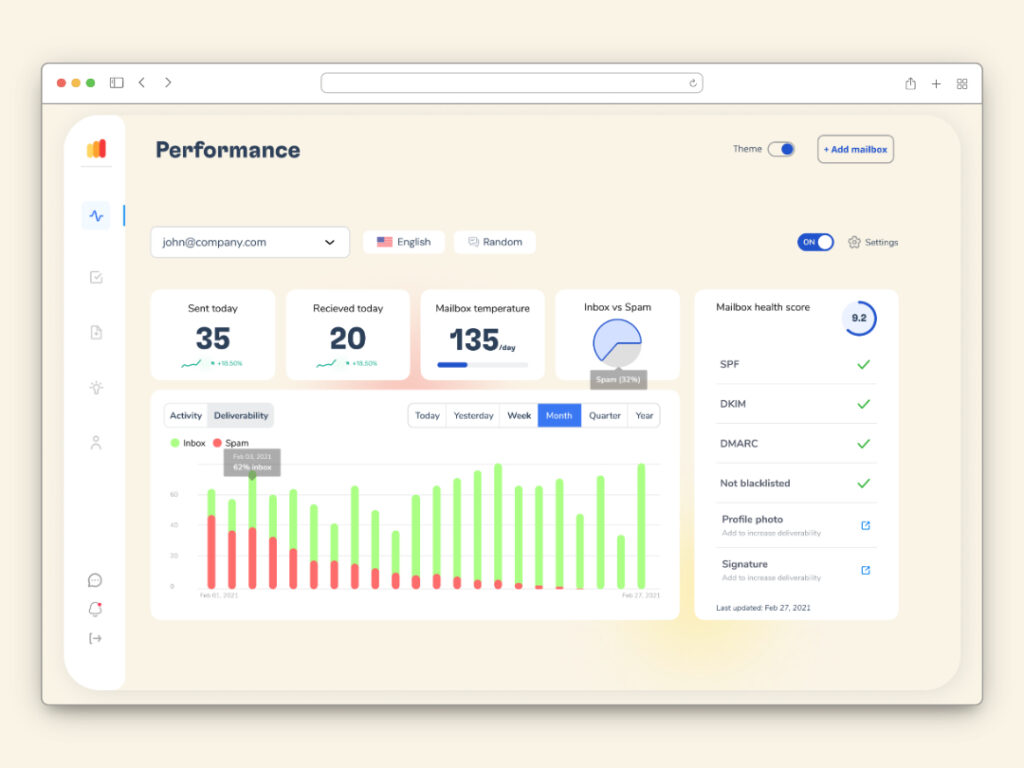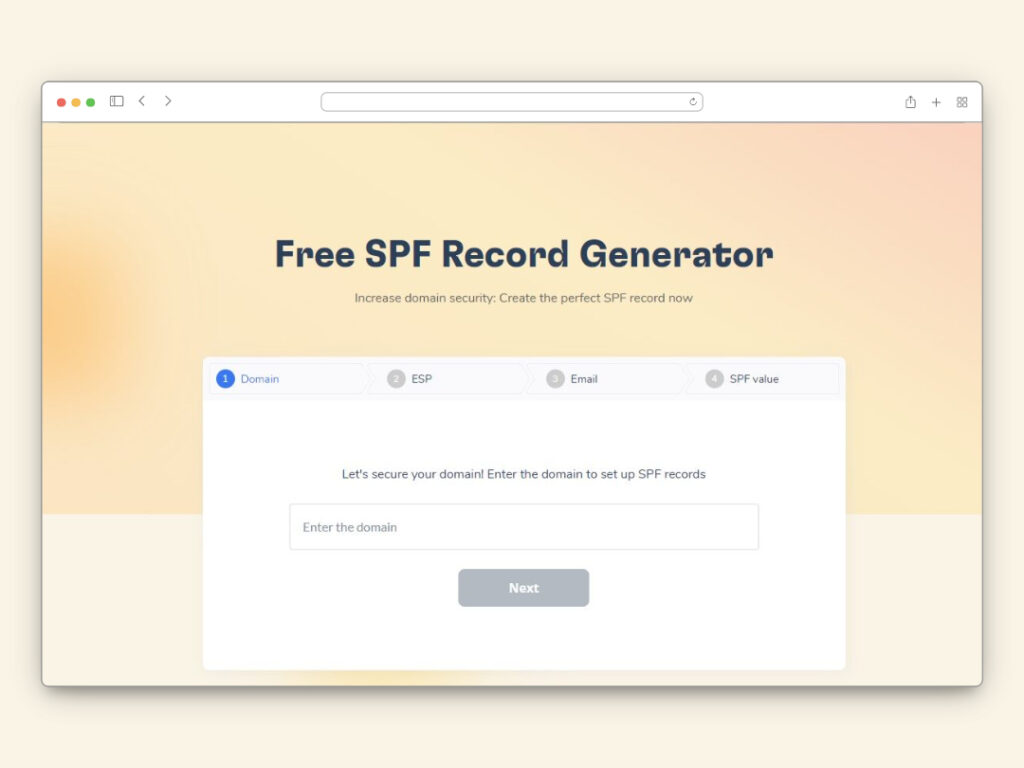The typical return is almost $42 for every dollar spent on email marketing. Email marketing not only endures but flourishes in the digital environment where marketing methods change at rapid speed. It’s about ensuring they land exactly where they should be – the recipient’s inbox – not only about messaging.
Welcome to the essential universe of email deliverability. This is the cornerstone of every email marketing campaign, not only a technical phrase for marketers to bandy around. Deliverability controls whether your well written emails land in your audience or vanish into the spam folder. Knowing and maximizing email deliverability becomes not only helpful but also necessary for separating out packed inboxes and producing actual results as companies send billions of emails every day.
What is email deliverability rate?
One important indicator of how successful your emails are in getting to the recipients’ inboxes free from spam filters’ filtering or blocking is email deliverability rate. It’s not only about whether your email was sent – that is, whether it avoided garbage folders and spam filters by being successfully delivered to the principal email address of the intended recipient.
Any email marketing effort’s effectiveness depends on knowing and preserving a high email deliverability rate. This rate directly affects the actual number of individuals that view and interact with your materials. Therefore, a high deliverability rate is really essential; it guarantees that your audience gets your communications, so optimizing the impact and efficacy of your email marketing activities.
How deliverability is measured?
Several important criteria together provide a whole picture of how successfully emails are reaching their intended targets, therefore indicating email deliverability.
Essential Measures of Email Deliverability
Delivery Rate. This statistic gauges the proportion of emails that arrived at the servers of the receivers without fail. Although it’s a beginning step in knowledge of deliverability, it does not ensure that the email arrived at the inbox as it can wind up in the spam folder.
Bounce Rate. Emails deemed “bounced” are those which the recipient’s email server rejects. Analyzing bounce rates is crucial since a high bounce rate can compromise your sender reputation. Hard bounces – permanent problems like invalid email addresses – and soft bounces – temporary problems like a full inbox – are the two categories into which bounces fall.
Open Rate. Although it’s not a direct indicator of deliverability to the inbox, the open rate can give hints about how many emails are reaching the inbox as opposed to the spam folder or not being sent at all.
Spam Complaints. Deliverability and sender reputation may be seriously affected by the frequency with which your emails are designated as spam by recipients tracked here.
Unsubscribe Rate. High unsubscribed rates could point to your material not connecting with your audience, which would cause ISPs to examine your emails more closely.
Methods Employed by Constant Contact to Track and Report Deliverability Metrics
Constant Contact uses sophisticated tools and methods to ensure accurate tracking and reporting of these metrics:
Real-time Analytics. Constant Contact provides real-time insights into how your emails are performing, including delivery rates, bounce rates, open rates, and more. This allows marketers to make immediate adjustments to improve performance.
Feedback Loops. By setting up feedback loops with major ISPs, Constant Contact receives information when recipients mark an email as spam. This data is crucial for maintaining a clean list and improving email practices.
Integrated Testing Tools. Before sending out a large campaign, users can test their emails with Constant Contact’s tools to check how different email clients display the emails and whether any elements might trigger spam filters.
Regular Updates to Sending Infrastructure. Constant Contact regularly updates its sending infrastructure and follows best practices for email authentication (like SPF, DKIM, and DMARC) to maintain trust with ISPs and ensure high deliverability.
Common issues affecting deliverability
Several important criteria together provide a whole picture of how successfully emails are reaching their intended targets, therefore indicating email deliverability. Knowing these benchmarks helps companies improve the placement of their emails to maximize inbox visibility.
Generic Issues Impacting Email Deliverability
Generic problems affecting email deliverability cover a spectrum of problems that could impede the effectiveness of an email marketing campaign. One of the main issues is poor list cleanliness; lists loaded with obsolete or erroneous email addresses usually have significant bounce rates, therefore compromising a sender’s reputation greatly. Furthermore, the inclusion of spammy content – that is, specific keywords or too frequent formatting like caps lock and multiple exclamation points – may activate spam filters, therefore increasing the possibility of emails ending up in the garbage bin.
Not engaging is another major problem. ISPs may view minimal interest in the emails recipients show – shown by few opens and interactions – as a hint that the material is not wanted, possibly sending next emails straight to the spam folder. Likewise, too high email frequency and volume can irritate receivers, leading to greater unsubscribed rates and spam complaints – both of which compromise deliverability.
Finally, poor configuration of protocols including SPF, DKIM, and DMARC can cause errors in email authentication, so rejecting emails or flaging them as spam by receiving servers. Improving email deliverability and guarantees successful email communication depend on addressing these problems.
Related – Configuring Constant Contact SPF, DKIM, and DMARC [Step-by-Step Guide]
Issues Specific to Constant Contact
List Management Practices. Constant Contact provides tools to manage email lists effectively, but misuse or neglect in maintaining list hygiene can lead to problems. For instance, not regularly removing unsubscribed or bounced email addresses can hurt deliverability.
Sender Reputation Management. Constant Contact helps manage sender reputation through various built-in tools and practices. However, if users consistently send low-quality content that triggers high spam complaints, even Constant Contact’s robust tools may not prevent a decline in sender reputation.
Over-Reliance on Automation. While Constant Contact offers automation tools to streamline email campaigns, excessive reliance without personalization or segmentation can lead to lower engagement, affecting overall deliverability.
Significant drops in deliverability
One of the most often occurring causes of a rapid drop in deliverability is running into spam traps. Service providers employ email addresses assigned for spam traps to identify spammers. Though not used for correspondence, they resemble standard email addresses. Sending to these addresses lets ISPs know the sender is not keeping excellent list hygiene, which can rapidly cause a damaged sender reputation.
Related – What is a Spam Trap & How to Avoid It | Warmy.io
Another major problem causing deliverability to collapse is blacklisting. Different companies keep blacklists and use them by email providers to screen possible spam. Should an IP address or domain of an entity find listing on a blacklist, their emails could be prohibited or directed straight to spam bins on several different email systems.
Related – Top 10 IP Address Blacklist Removal Tools [Cons & Pros]
Deliverability problems also have some influence from technical shortcomings. These could be issues with the email server, faults in the email sending system, DNS configuration errors including erroneous SPF, DKIM, or DMARC records. Such technological problems can prevent emails from being delivered correctly, therefore causing unexpected declines in deliverability.
Related – Why Do You Need to Configure SPF, DKIM, DMARC and How To Set Them
To find and fix the underlying reasons of deliverability failures, addressing these problems sometimes calls for an extensive audit of email practices, technical settings, and list management techniques. You can easily do it with Email Deliverability Test
Reliability of deliverability numbers
For marketers trying to evaluate the actual success of their email campaigns, the accuracy of stated deliverability measurements can sometimes be a source of anxiety. Making wise email strategy decisions depends on an awareness of the limits and possible errors of these measures.
Potential Inaccuracies in Deliverability Metrics
Although deliverability measures are meant to show how many emails find their way into recipients’ inboxes, reality is that these figures might not always paint a whole or true picture. For example, an email identified as “delivered” might have wound up in a spam bin instead of the inbox. This often results from the metrics for delivery, which mostly verify that the recipient’s server has accepted the email rather than necessarily that it has reached the inbox.
The Misleading Nature of Open Rates
Usually used as a gauge of deliverability and involvement are open rates. But given the way opens are recorded, they can be deceiving. Usually, email open tracking consists in inserting a little transparent graphic in the email that loads when the email is opened. Though the receiver actually read the email, the open will not be reported if the recipient’s email software is set not to show photos automatically.
Moreover, recent privacy updates, such as Apple’s Mail Privacy Protection, have further complicated the reliability of open rates. These features prevent senders from knowing whether an email has been opened, as they automatically load tracking pixels regardless of user interaction. This change can inflate open rates artificially, giving a false sense of engagement.
Related – Boost Your Email Open Rates: 10 Practical Strategies
Challenges with Other Metrics
Other metrics like click-through rates or bounce rates are also subject to inaccuracies. For example, a low bounce rate might suggest good list health and high deliverability, but it could also indicate that emails are reaching inactive or unengaged subscribers who do not report or move unwanted emails to spam. Similarly, click-through rates depend heavily on the email’s content and design, and a high rate may not necessarily correlate with overall campaign success if the final conversion rates do not align.
How to improve your Constant Contact deliverability

Although navigating email deliverability might be intimidating, with the correct tools the process becomes controllable and successful. Warmy.io is a complete answer meant to address typical deliverability problems directly, therefore improving the general effectiveness of email marketing efforts.
Designed especially to improve email deliverability and promote your sender reputation, Warmy.io is a basic email warm-up solution. Any company depending on email communications must pay great attention to this since a strong sender reputation guarantees that emails reach their intended inboxes instead of being buried in spam folders.
Purpose and Benefits
- Warmy.io methodically raises the trustworthiness of your email by guaranteeing regular and slow sending volumes—which is essential for keeping good standing with Internet Service Providers (ISPs).
- Warmy.io helps lower the possibility of your emails being designated as spam by consistently warming up your email domain, therefore boosting the rate at which emails are successfully delivered to recipients’ inboxes.
Features and Promotions of Warmy.io
👉 Free Email Deliverability Test

This tool allows you to see exactly where your emails are landing—be it the inbox, spam folder, or elsewhere. It provides a detailed deliverability score, checks if your IP is blacklisted, and identifies any authentication issues that could affect your sending reputation. This test is crucial for understanding and improving your email strategies. Try the Warmy.io Free Email Deliverability Test here.
👉 SPF and DMARC Record Generator.

Simplifies the creation of these crucial email authentication records which are essential for preventing spoofing and ensuring your emails are recognized as legitimate.

Helps optimize your email content, ensuring it is free of elements likely to trigger spam filters.
Assists in creating professional and compliant email signatures that can add a layer of trust and authenticity to your messages.
Provides guidelines on optimal sending frequencies and volumes to avoid overwhelming your recipients.
Enables the crafting of effective email sequences that engage and convert, adjusting based on recipient actions and feedback.
Experience the full capabilities of Warmy.io with a 7-day free trial, allowing you to test and measure the enhancements in your email deliverability and performance. This trial period is an excellent opportunity for businesses to see firsthand how Warmy.io can revolutionize their email strategies without any initial investment.
Conclusion
Keeping great deliverability with Constant Contact, or any email marketing tool, comes with a lot of difficulties. The stakes are high since the efficiency of digital marketing initiatives depends on the ability to reach a customer’s inbox directly, therefore affecting the bottom line.
These difficulties, nevertheless, are not insurmount. Warmy.io provides creative ideas meant to improve email delivery using tools like Businesses may greatly increase their engagement and deliverability rates by acting early to warm up email domains, confirm email authentication, and regularly monitor email performance.
Achieving and sustaining high email deliverability is not only attainable but also a regular driver of success in your digital marketing activities with the correct tools and approaches.
📜 Related articles:
FAQ
What is Constant Contact deliverability?
Constant Contact deliverability refers to the effectiveness with which emails sent through Constant Contact reach the recipients' inboxes. It measures how successfully the platform navigates through spam filters and other barriers to ensure emails are delivered as intended.
How can I improve my deliverability with Constant Contact?
To enhance your Constant Contact deliverability, regularly clean your email list, ensure your content is engaging and not spam-like, use segmentation to target your emails better, and make sure all technical settings for email authentication are correctly configured.
What tools does Constant Contact offer to help monitor deliverability?
Constant Contact provides various tools to help monitor email campaign performance, including real-time analytics for open rates, bounce rates, and spam reports. These tools help identify deliverability issues and guide improvements.
Are there specific types of content that affect Constant Contact deliverability?
Yes, overly promotional content, the excessive use of links or images, and certain trigger words can negatively impact deliverability. Constant Contact advises adhering to content guidelines that favor engagement and relevance to avoid spam filters.
How does Constant Contact handle emails that end up in spam?
Constant Contact has mechanisms in place to minimize emails landing in spam, such as compliance with email sending best practices and providing tools for proper list management. However, if emails do end up in spam, analyzing feedback loops and adjusting strategies accordingly is essential.











